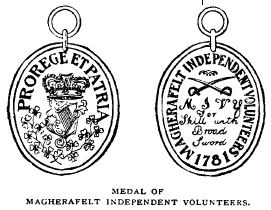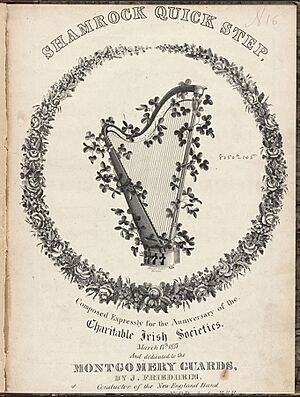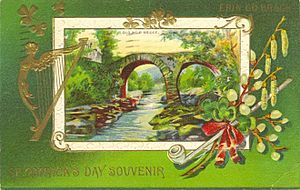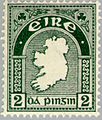Shamrock facts for kids
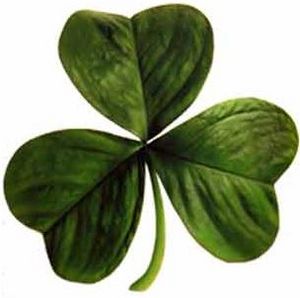
Shamrocks are small, young clover plants. They are a very important symbol of Ireland. People often say that Saint Patrick used a shamrock to help explain the idea of the Holy Trinity. The word shamrock comes from the Irish word seamróg. This means "little clover" or "young clover." Sometimes, other plants with three leaves are also called shamrocks. Shamrocks can even be used for medicine. They were a popular design in the Victorian times. Around March 17, which is Saint Patrick's Day, you can often find small pots of shamrocks for sale. Many people wear a shamrock on their clothes to celebrate the holiday.
Shamrock and Saint Patrick
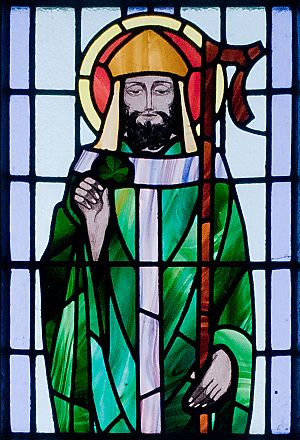
People traditionally believe that Saint Patrick used the shamrock to teach about the Christian idea of the Holy Trinity. This happened when he was bringing Christianity to Ireland in the 400s. The first time we see a clear link between St. Patrick and the shamrock is on some old coins from 1675. These coins show St. Patrick speaking to people while holding a shamrock. This suggests he was using it to explain the Holy Trinity.
When Saint Patrick arrived in Ireland, he used the shamrock to teach people who followed older religions about the Holy Trinity. In ancient Ireland, the number three was very important. The Irish people had many gods that appeared in groups of three. This might have helped St. Patrick in his teaching. Some experts say there is no proof that clover was sacred to the Celts. However, others believe the shamrock was likely connected to nature and its power to grow. Today, the shamrock's meaning is strongly tied to Christianity. Pictures of Saint Patrick often show him holding a cross in one hand and a shamrock in the other.
The first time the link between St. Patrick and the shamrock was written down was in 1681. This was in a travel story by an English visitor to Ireland named Thomas Dineley.
Shamrock: A Symbol of Ireland
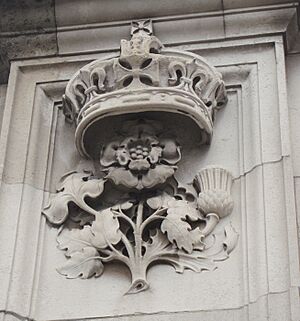
Because St. Patrick is Ireland's special saint, the shamrock has been a symbol of Ireland since the 1700s. It is like how a rose is a symbol for England, a thistle for Scotland, and a daffodil for Wales. The shamrock started to become a national symbol when different groups in Ireland used it during the political changes of the late 1700s.
One group was called the Volunteers. They were local armies in Ireland in the late 1700s. They were formed to protect Ireland from France and Spain. This happened when British soldiers left Ireland to fight in the American Revolutionary War. Another group was the United Irishmen. They were a revolutionary group who wanted change.
The Volunteers used the shamrock on their flags and medals. The United Irishmen chose green as their color and wore green clothes or ribbons. This green was often linked to the shamrock. A famous song called The Wearing of the Green tells about their actions and often mentions the shamrock. Their flag, called the Erin go bragh flag, often showed shamrocks. In 1799, a newspaper supporting their cause was even called The Shamroc.
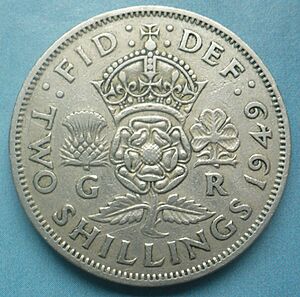
After the Acts of Union in 1800, which joined Britain and Ireland, the shamrock was added to the Royal Coat of Arms of the United Kingdom. It was shown growing from one stem with the rose of England and the thistle of Scotland. This showed the three kingdoms were united. Since then, the shamrock has often appeared with the rose, thistle, and sometimes the leek for Wales. You can see it on British coins, like the two-shilling coin, and on stamps. The rose, thistle, and shamrock design is also often seen on British public buildings, such as Buckingham Palace.
During the 1800s, the shamrock became even more popular as a symbol of Ireland. It was shown in many pictures on things like book covers and St. Patrick's Day postcards. It was also mentioned in many songs and poems. For example, a popular song called The Shamrock Shore talked about the state of Ireland in the 1800s. Another famous example is a poem by Thomas Moore called Oh the Shamrock. This poem was very popular and helped make the shamrock a well-known image of Ireland:
Oh The Shamrock
-
Through Erin's Isle,
To sport awhile,
As Love and Valor wander'd
With Wit, the sprite,
Whose quiver bright
A thousand arrows squander'd.
Where'er they pass,
A triple grass
Shoots up, with dew-drops streaming,
As softly green
As emeralds seen
Through purest crystal gleaming.
Oh the Shamrock, the green immortal Shamrock!
Chosen leaf
Of Bard and Chief,
Old Erin's native Shamrock!
In the 1800s and 1900s, the shamrock continued to appear in many places. For example, it was used as a decoration on many buildings in Ireland. You can see it on the Kildare Street Club building in Dublin, St. Patrick's Cathedral, Armagh, and the Harp and Lion Bar in Listowel, Co. Kerry. It also appears on street items, like old lampposts in Mountjoy Square in Dublin. You can also find it on monuments like the Parnell Monument and the O'Connell Monument in O'Connell Street, Dublin. Shamrocks were also used on decorative items like glass, china, jewelry, poplin fabric, and Irish lace. For example, Belleek Pottery in Co. Fermanagh often uses shamrock designs.
Images for kids
-
An Aer Lingus Airbus A320 with a shamrock on its tail fin
-
Lamppost in Mountjoy Square, Dublin, early 20th century
-
Work by Belleek Pottery, which often features shamrock motifs
-
2d Map of Ireland: the first Irish postage stamp featured the shamrock.
-
Shamrock on the tail fin of an Airbus A321neo of Aer Lingus
-
Panathinaikos F.C. shirt
See also
 In Spanish: Shamrock para niños
In Spanish: Shamrock para niños


